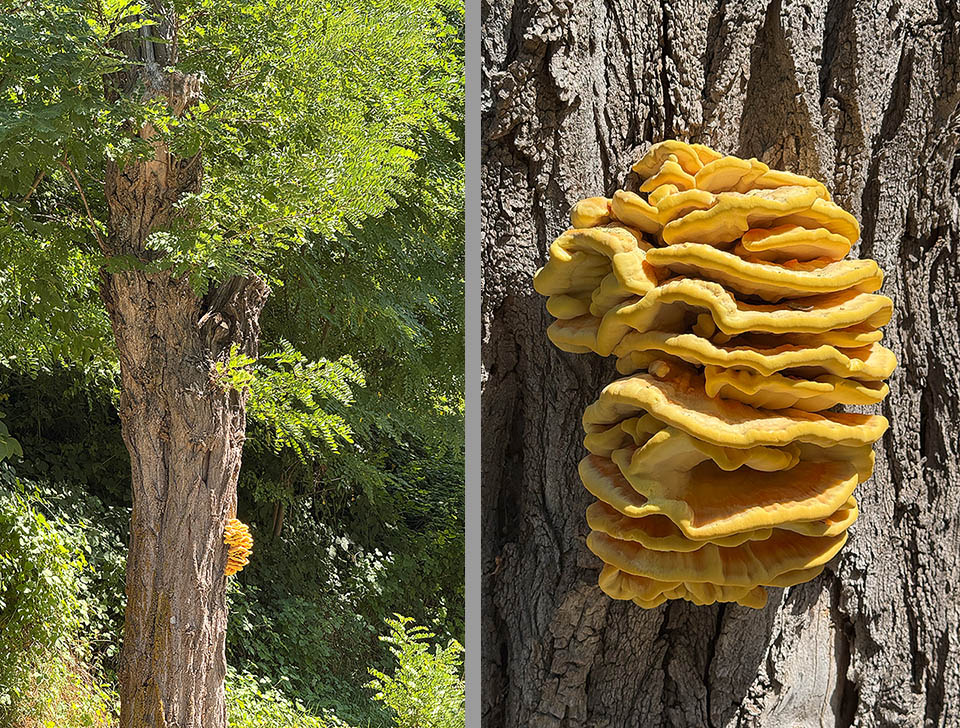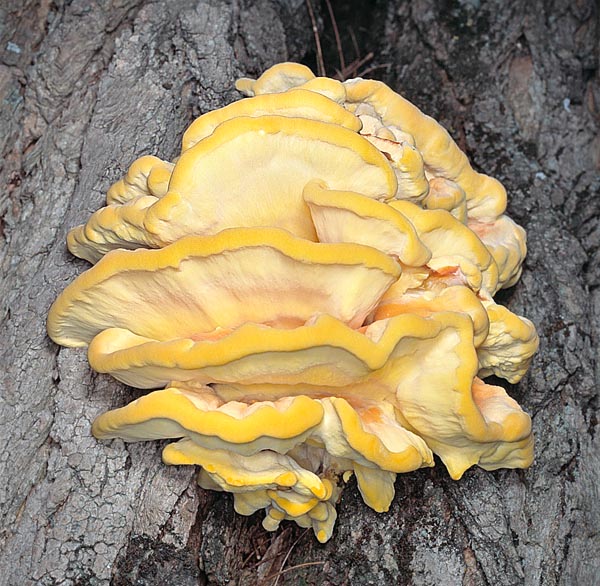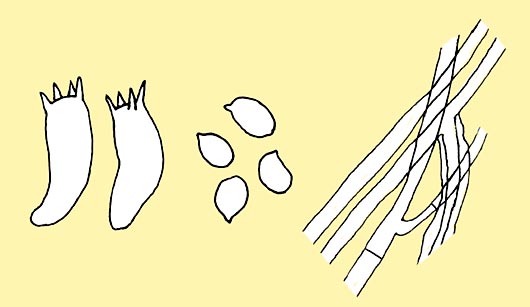
Text © Massimiliano Berretta

English translation by Mario Beltramini

Laetiporus sulphureus is a parasite that grows only on broadleaf trees, here on an old black locust tree trunk (Robinia pseudoacacia) © Giuseppe Mazza
Family: Fomitopsidaceae Jülich, 1982.
Genus: Laetiporus Murril, 1904.
Laetiporus sulphureus (Bulliard : Fries) Murril, 1920.
The Latin term “sulphurous” means sulphurous, due to the orange-yellow colour of the whole basidiome. In Italy it is called “Fungo del carrubo”, “Fungo dello zolfo”; in Spain “Políporo azufrado”; in France, on the contrary, is known as “Polypore soufré”; in Germany “Schwefel-Porling”; in the United Kingdom “Chicken of the woods”, “Mushroom chicken”.

It is only edible when young, when the flesh is soft and succulent © Giuseppe Mazza
Description of the genus
To this genus belong annual basidiomes, of great dimensions (10-40 cm), fan-shaped and often imbricate, pileated, sessile or sub-stipitate, of yellow-orange or pink colour, fleshy and succulent when young, very frail when dried; yellow porous surface; yellow context, brown when fully ripe; dimitic hyphal system with septated generative hyphae and without clamp connections, hyaline connective hyphae; ellipsoidal spores, hyaline and not amyloid. They cause the brown rot on the conifers as well as on the broad-leaf trees. There are 5 known species belonging to this genus.
The type species is : Laetiporus sulphureus.
Description of the species
Cap : annual basidiomes, sessile or sub-stipitate, single or imbricate, mostly fan-shaped, flabelliform, semi-circular, 10 to 40 cm of diameter, fleshy when fresh, of bright orange-yellow colour, fading when adult; the pileus surface is nodulose and lumpy, the margins are wavy, lobed and paler.
Hymenium : solferino yellow pores, later on ochraceous, round-angular, 2-4 per mm, dissepiments initially entire then toothed; the tubules are 3-4 mm long, of the same colour as the pores.
Stem : it does not have a true and proper stem, at times they are attached to the substratum through a restricted part of the carpophore, so much to simulate a pseudo-stem.
Flesh : the flesh is soft and succulent, of yellowish-white colour, and of 1 to 3 cm of thickness, homogeneous, slightly darker towards the cuticula.
Habitat : it is usually a parasite of broad-leaf trees, rarely of conifers; it prefers the oaks and the chestnut tree.
Edibility : choice edible when young.

Basidia, spores, generative hyphae and connective hyphae © Pierluigi Angeli
Microscopy : dimitic hyphal structure with skeletal hyphae strongly ramified, with broad hyphal wall at the centre, hyaline, with big wall; hyaline generative hyphae of 3-20 µm of diameter without clamp connections; basidia 15-18 × 5-7 µm; hyaline basidiospores, white in mass, not amyloid, smooth, ellipsoidal to ovoid, 5-7,5 × 4-4,5 µm.
Remarks : it is a diffused and cosmopolite species, very common on Quercus in Europe, in Italy, it seems to be less selective, preferring however Quercus, Castanea sativae and Picea abies. It is not rare to encounter this basidiome also on fruit trees, especially on the apple tree, whilst in the central and western regions of the USA it seems to prefer only the conifers. It is considered a good edible especially in some zones of Italy, like, for instance, in Sicily, whence comes the current name of “Fungo del carrubo” (Mushroom of the carob tree), and in some zones of France.
It may be mistaken with other species growing on the wood such as: Polyporus squamosus (Hudson) Fries 1821, decorated by brown scales on the cap and with great and angular whitish pores and a short and stocky lateral stipe, blackish brown at the base; Meripilus giganteus (Persoon) P. Karsten 1882, which has brown cap, but is yellow-sulphur at the very beginning of its growth, the small pores, white-yellowish and, above all, if touched turns black in short time. Of this polypore, as well of others, exist anamorphic forms, which present with the typical colourations of the species but without porous surface, smaller, and reproducing through chlamydospores.
Synonyms :
Boletus sulphureus Bulliard 1789 (basionym); Cladomeris sulphurea (Bulliard)Quélet1886; Cladoporus sulphureus (Bulliard) 1986; Grifola sulphurea (Bulliard) Pilát 1934; Leptoporus sulphureus (Bulliard) Quélet 1888; Merisma sulphureum (Bulliard) Gillet 1878; Merisma sulphureus (Bulliard) Gillet 1878; Polypilus sulphureus (Bulliard) P. Karsten 1881; Polyporus sulphureus (Bulliard) Fries 1821; Sistotrema sulphureum (Bulliard) Rebentisch 1804; Tyromyces sulphureus (Bulliard) Donk 1933.
→ For general notions about Fungi please click here.
→ To appreciate the biodiversity of MUSHROOMS please click here.
